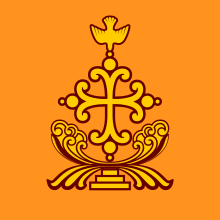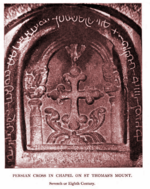
Mar Thoma Sleeva (Saint Thomas Cross) are ancient crosses associated with the community of Indian subcontinent, who trace their origins to the evangelism of Thomas the Apostle in the 1st century AD. The Saint Thomas Christians, which is one of the oldest Christian communities of the world, survive in the Malabar region in state of Kerala, India and have a diaspora in other parts of the Indian subcontinent. Saint Thomas Christian crosses are known as Mar Thoma Sleeva (Saint Thomas cross), Indian cross, or Persian Cross in English, as well as Nasrani Sthambam in Malabarese.
Mar Thoma Sleeva are found at Kadamattom, Muttuchira, Kothanalloor, Kottayam, Pallippuram and Alangad in the South Indian state of Kerala. Saint Thomas Christian Crosses have been also found in other parts of the Indian subcontinent, such as Agacaim (Goa), St Thomas Mount (Tamil Nadu), Anuradhapura (Ceylon), Taxila (Pakistan), and in Baltistan. Floriated Indian crosses are found at Kottakkavu, Pallipuram and Niranam. The large open-air rock crosses known as Nasrani Sthambams are found on the facades of many Thomasine Churches. Before the arrival of Portuguese explorers, there were more than 150 Syriac churches in Malabar/Kerala.
Etymology
Mar Thoma Sleeva (also written as Mar Thoma Slīva) is a Syriac-language term which means Saint Thomas cross.

Antonio Gouvea states in his 16th-century work Jornada that the old churches of Saint Thomas Christians were full of crosses of the type discovered at S. Thome (Mylapore). He also states that veneration of the cross is an old custom in Malabar. Jornada is the oldest known written document which calls the cross cross from (of) Sam Thome (Mylapore). The original phrase used is Cruz de Sam Thome, meaning "Cross of (from) St. Thomas". For this reason, it can also mean "Cross from Sam Thome", where Mylapore is equivalent to Sam Thomé, the name that the given by the Portuguese to the city of Mylapore. Gouvea also writes about the veneration of the Cross at Cranganore (Kodungallur), mentioning it as Cross of Christians.
Locations
Mar Thoma Sleeva can be found at the following locations:
| The crosses are at the following locations: | ||||
|---|---|---|---|---|
| Sl. no. | Location | Preserved at | Image | Notes
|
| 1 | Mylapore, Tamil Nadu | Our Lady of expectations Church, St. Thomas Mount |
 |
Under Roman Catholic diocese of Chingelpet. |
| 2 | Alangad, Kerala | Saint Mary's Church, Alangad | Under Syro-Malabar Church. | |
| 3 | Kottayam, Kerala | Saint Mary's Knanaya Valiyapalli |  |
Believed to have originally been exhibited at the churches built by the merchant Knai Thoma in Kodungallur. Later moved to Kaduthuruthy Knanaya Church due to the destruction of the Knanaya settlement of Kodungallur in a battle between the Kingdom of Kozhikode and the Kingdom of Kochi in 1524. Finally moved to St. Mary's Knanaya Church Kottayam at its erection in 1550 C.E.
The left altar cross was dated between the 7th and 8th century by Assyriologist C.P.T Winkworth in 1928. |
| 4 | Kottayam, Kerala | Saint Mary's Knanaya Valiyapalli |   |
Believed to have originally been exhibited at the churches built by the merchant Knai Thoma in Kodungallur. Later moved to Kaduthuruthy Knanaya Church due to the destruction of the Knanaya settlement of Kodungallur in a battle between the Kingdom of Kozhikode and the Kingdom of Kochi in 1524. Finally moved to St. Mary's Knanaya Church Kottayam at its erection in 1550 C.E.
The right altar cross was dated to the 10th century by Assyriologist C.P.T. Winkworth in 1928. |
| 5 | Muttuchira, Kerala | Ruha d' Kudsha Church | Under the Syro-Malabar Catholic Eparchy of Palai. | |
| 6 | Kadamattam, Kerala | Saint George Church |  |
Under Indian Orthodox Church. |
| 7 | Kothanalloor, Kerala | St Gervasis and Prothasis Church | Under Syro-Malabar Catholic Major Archeparchy of Ernakulam-Angamaly. | |
| 8 | Agasaim, Goa | Pilar Seminary Museum | ||
| 9 | Anuradhapura, Sri Lanka | Anuradhapura museum | This cross is considered to be the oldest cross in Sri Lanka. It was found in 1912 during excavations of Anuradhapura. | |
Other similar crosses:

- Taxila, Pakistan. It is a very small cross that found in a field near the ancient city Sirkap near Taxila. The cross is kept at the Cathedral Church of the Resurrection, Lahore. However, experts point out that the cross shares only one characteristic with other St Thomas crosses: mostly equilateral, with arms of equal length. They claim that the Christian antiquity of this cross cannot be conclusively proven, as the same characteristic is also observed in pre-Christian Buddhist crosses and Swastika-variants found in the region, and even in Greek crosses.
- An Indian cross is depicted on the rock-piece at the front of the Parur (North) church, first published in the St Thomas Christian Encyclopaedia of India, Vol.II, 1973, Ed. George Menachery.
- There is a St Thomas cross in stone on the porch of the Church of St Thomas the Apostle, Killinghall, carved by Charles Mawer of Leeds.
Interpretation of the inscriptions
In 1873, an archaeologist named Arthur Coke translated the inscriptions as follows:
- "In punishment by the cross (was) the suffering of this one;
- He who is the true christ, and God above and Guide ever pure."
F. C. Burkitt and C. P. T. Winckworth, the then-reader of Assyriology in the University of Cambridge, studied the inscriptions and produced a translation, which was then discussed at the 1925 International Congress of Orientalists at Oxford.
The interpretation is as follows:
- "My Lord Christ, have mercy upon Afras son of Chaharbukht the Syrian, who cut this (or, who caused this to be cut)."
On the large cross, there is this additional sentence in Estrangelo Syriac. (Galatians 6:14)
- "May I never boast except in the cross of our Lord Jesus Christ."
The inscription at Kadamattom church when translated is,
- "I, the beautiful bird of Nineveh has come to this land. Written by me Shapper, who was saved by the Holy Messiah from misery."
Symbolism of Mar Thoma Sleeva
Unlike crosses in other traditions, the St Thomas cross does not carry the effigy of the Christ. In addition to this unique quality, each of its elements carry symbolic meanings. Generally the Cross symbolizes life rather than death and suffering.
- Lacking the effigy of Jesus, the St Thomas cross presages the discovery of the empty tomb, glorifying the Resurrection of Jesus.
- The four edges of the cross are floral in shape, symbolizing fruition and life from the tree of life.
- The lotus flower beneath the cross is a symbol of Buddhism and India. A cultural adaptation of local imagery, the cross fixed on the lotus would symbolize Christianity in India in the first century.
- The three steps below the Cross represent Golgotha, symbolically referring to the death of Jesus, also the three decks of the Ark and the ascent to Mt. Sinai.
- Finally, the dove above the cross represents the Holy Spirit, the third person of the Holy Trinity according to the Christian tradition. It is this spirit that raised Jesus from the dead and bestows gifts upon the Church's faithful.
Stone crosses of Kerala

Kottakkavu Mar Thoma Syro-Malabar Church, North Paravur and St Mary's Syro-Malabar Forane Church, Pallipuram under the Major Archeparchy of Ernakulam-Ankamaly of the Syro Malabar Church and St Mary’s Orthodox Syrian Church, Niranam under the Niranam diocese of the Malankara Orthodox Syrian Church have the ancient, floriated Saint Thomas Christian crosses.
Nasrani Sthambam
Nasrani Sthambams are giant open-air stone crosses. The plinths of these crosses represent lotus petals and lotus flowers, and they have square bases. They have various iconographic motifs, including elephants, peacocks and other animals. These crosses are found in Puthenchira, Parappukkara, Veliyanad, Kalpparambu, Angamaly, Kanjoor, Malayattoor, Udayamperoor, Kuravilangad, Uzhavoor, Chungam, Kaduthuruthy, Muthalakodam, Muttuchira, Kudamaloor, Niranam, Arakuzha, Kothamangalam, Chengannur, Thumpamon, Chathannur and many other places.
See also
References
- The Encyclopedia of Christianity, Volume 5 by Erwin Fahlbusch. Wm. B. Eerdmans Publishing - 2008. p. 285. ISBN 978-0-8028-2417-2.
- The Jews of India: A Story of Three Communities by Orpa Slapak. The Israel Museum, Jerusalem. 2003. p. 27. ISBN 965-278-179-7.
- Cf. The first dozen articles in the St Thomas Christian Encyclopaedia of India, Vol. II,1973, Ed George Menachery
- Vazhuthanapally, ”Archaeology of Mar Sliba”.
- O'Flynn, Donnel (2017). Holy Cross, Life-Giving Tree. Church Publishing, Inc. p. 74. ISBN 978-0-8192-3368-4.
- ^ "Analogical review on Saint Thomas Cross - The symbol of Nasranis-Interpretation of the Inscriptions". Nasrani.net. 29 February 2008.
- "A huge "Cross" is found in the highlands of Kavardo mountains in Pakistan's Baltistan region". Pamir Times. 14 June 2020. Retrieved 5 September 2020.
He further calls the Kovardo cross as 'a typical Thomanian Cross of India' and is astonished by the size of it.
- ^ "Stone Crosses of Kerala". Nasrani.net. 16 January 2007.
- Malabar Manual by William Logan - 1996 published by Asian Educational Services
- Antony, M. T. (2011). "Saint Thomas Cross: A Religio-Cultural Logo of Saint Thomas Christians". The Way of Life, A Festschrift in Honour of Prof. Dr Varghese Pathikulangara, CMI. Denha Services Publications: 237–270. ISBN 978-93-81207-00-0 – via NSC Network.
- ^ Antonio Gouvea, Jornada of Dom Alexis de Menezes
- "kothanalloorchurch.org". Archived from the original on 28 September 2007. Retrieved 8 November 2010.
- Picture and description in the St Thomas Christian Encyclopaedia of India, Ed. George Menachery, Vol.I, 1982 in article Christianity in Pakistan by Bishop Young,
- ^ Rooney M.H.M, Fr. John (1984). Shadows in the Dark (Pakistan Christian History Monograph No. 1). Christian Study Center, Rawalpindi. pp. 42–45. Archived from the original on 18 March 2012.
{{cite book}}: CS1 maint: bot: original URL status unknown (link) - Rashid, Salman (16 December 2011). "Taxila Cross - The Express Tribune". The Express Tribune. Retrieved 23 December 2017.
- Rashid, Salman (5 July 2014). "Taxila Cross". Retrieved 23 December 2017.
- Rashid, Salman (10 March 2013). "St Thomas in Taxila". Retrieved 23 December 2017.
- See image: File:St Thomas Killinghall 667.JPG
- On some Pahlavī inscriptions in South India (1873) by Arthur Coke Burnell, page 11
- The Journal of Theological studies (1929), P-241, NSC Network (2007)
- "St Thomas Cross". Thenazrani.org. Archived from the original on 4 December 2016. Retrieved 25 August 2008.
- Rock Crosses of Kerala, by George Menachery, 2000
- Rock objects in Kerala Churches, in George Menachery, Glimpses of Nazraney Heritage, SARAS, Ollur, 2005
- Menachery, George. "Rock Crosses of Kerala". 2007.
- George Menachery, Indian Church History Classics Vol.I "The Nazranies", Ollur, 1998. It has photos of dozens of Rock Crosses
- "Plaza Crosses of St. Thomas Christians". Sahapedia. Retrieved 6 April 2022.
External links
- "St Thomas cross". Archived from the original on 4 December 2016. Retrieved 25 August 2008.
- "Analogical review on St Thomas cross- The symbol of Nasranis". 29 February 2008. Archived from the original on 12 October 2010.
- Antony Dr.Martin Thomas (14 June 2020). "Saint Thomas Cross- A Religio Cultural Symbol Of Saint Thomas Christians". Archived from the original on 24 March 2020.
- "Menanchery article on Rock crosses of Kerala". Archived from the original on 2 November 2007.
- "Daily News report on Crosses in Sri Lanka". Archived from the original on 30 September 2007.
- "Stone Crosses of Kerala". 15 January 2007.

